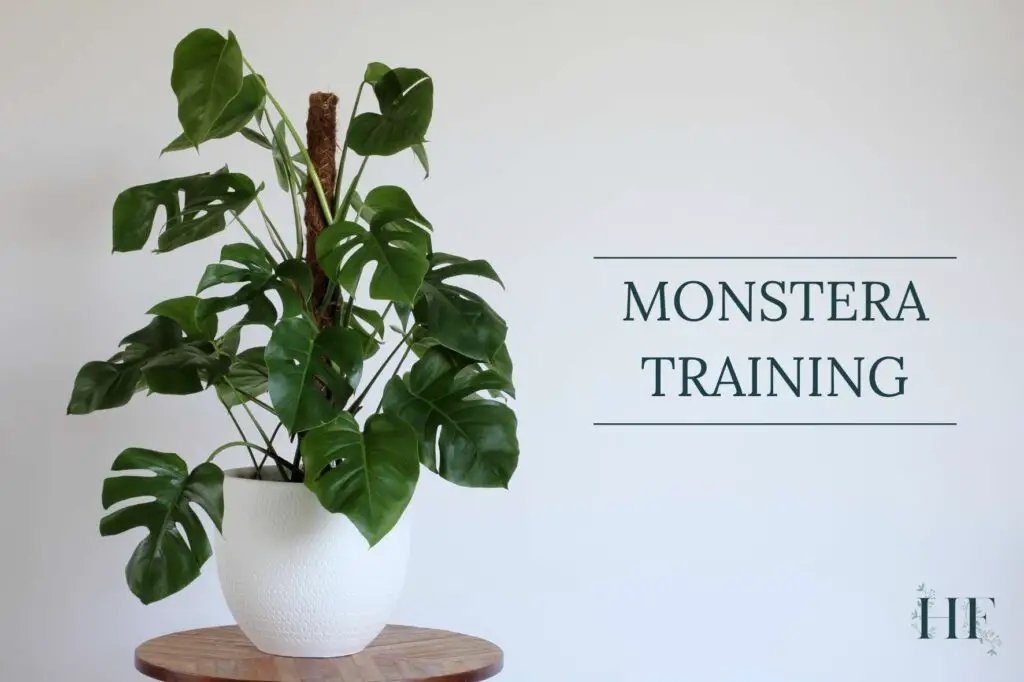For both Monstera Deliciosa and Monstera Adansonii lovers, one of the best parts of growing these plants indoors is their ability to grow quite big, transforming the space they inhabit into a jungle-like interior.
But, unlike other popular houseplants with an upward, tree-like growth pattern (such as the fiddle-leaf fig or rubber plant), Monsteras grow like a vine and need something to support their rapid growth.
So, do you need to train your Monstera? When do you need to support it? And how do you train your Monstera to climb? In this blog post, I will be answering these questions and going through different Monstera support ideas too.
Monstera Training FAQ
Should I Train My Monstera?
Or rather… Does your Monstera need a moss pole (or another support structure)?
By providing a support structure such as a moss pole, coco coir pole, or trellis, you can encourage your Monstera Deliciosa and Adansonii to grow upright. Training your Monstera allows the plant to follow its natural inclination for climbing and can lead to a healthier plant with larger leaves.
If your Monstera is still young, growing upright, and none of the stems are growing to the side, you probably don’t need a pole or trellis just yet. This is the case for young Monsteras that are still in their nursery pot or a recently rooted cutting.
On the other hand, if your Monstera is starting to grow to one side or trailing over the side of the pot, it is time to start thinking about adding support. An older Monstera will grow horizontally as it expands outward.
Further down I will go through the signs to stake your Monstera, i.e., when the plant tells you it’s time to provide a support structure.
Should I Give My Monstera Something to Climb?
Although you don’t have to provide any type of support to keep your Monstera growing, you can support your Monstera in order for it to either grow more like a tree (upward) or like a vine (climbing into a wall or other support system).
You can give your Monstera’s climbing vines a sturdy moss pole or trellis, so they can grow upwards, directing how they expand and how much room they take.
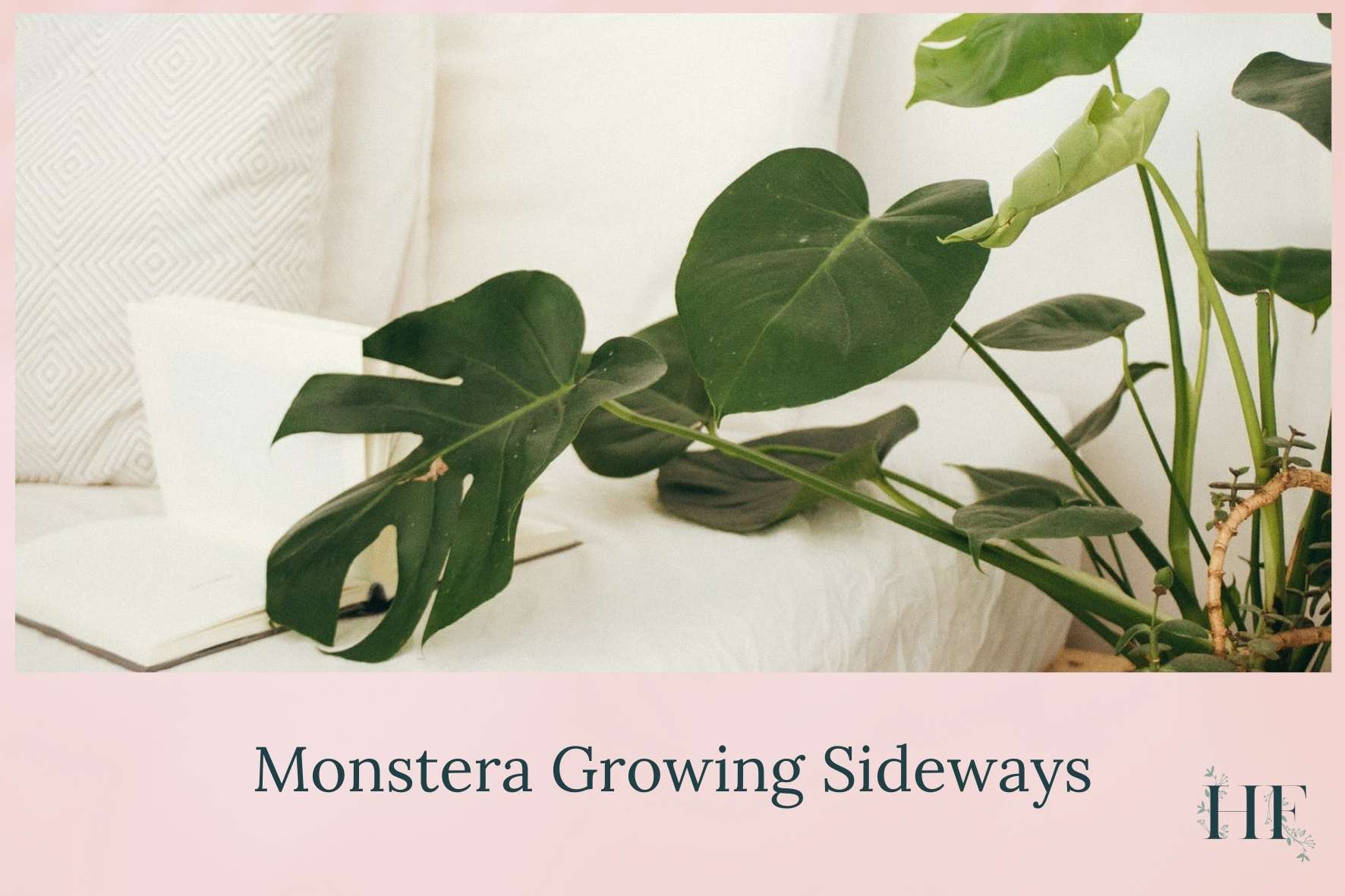
Why Is My Monstera Plant Growing Sideways?
A Monstera grows vertically on just a few stems when it’s young.
But, as your Monstera matures, its stems and leaves get bigger and heavier too. Without adequate support, your Monstera grows sideways due to gravity.
A Monstera growing to the side is a common issue when no support to climb is provided.
The best way to keep a Monstera growing upright is to stake it using a support such as a moss pole or trellis.
Why Do Monsteras Need Moss Poles?
Monsteras are vining plants and climb up trees in their natural jungle habitat. Their aerial roots attach to the bark to provide support to their large leaves and heavy stems. When caring for them as houseplants, you can replicate this fact and trait using a pole or other vertical support.
Many other popular houseplants like pothos and philodendrons grow the same way in the wild, but they are generally displayed as trailing plants indoors. Unlike these plants, Monsteras’ size and weight make it too unwieldy to grow as a hanging or trailing plant in most situations.
Monsteras need a moss pole, trellis or another vertical support structure because it allows them to grow upward towards the light without falling over and damaging their stem.
Here are the three main reasons to stake a Monstera (i.e., why they need support):
- It replicates its natural habitat.
- Your Monstera will grow taller with bigger leaves and more fenestrations.
- It will help you direct its growth and avoid your Monstera from growing sideways.
Let’s go through these reasons for you to consider giving your Monstera vertical support and the benefits they provide:
1) Replicate Natural Habitat
In their natural tropical habitat, Monsteras climb up trees to reach better sunlight using their aerial roots, whose function is to anchor the plant to a support (a tree in this case) and to take up moisture and nutrients from the air.
A moss pole, trellis or stake acts like a tree and supports the Monstera providing it with a surface to climb into. Also, moss poles hold onto extra moisture, which attracts the Monstera’s air roots, mimicking natural humidity and rainfall.
2) Grow Bigger Leaves and Encourage Fenestrations
The extra physical support (this being a tree in the wild or a pole indoors) encourages your Monstera to grow bigger because its energy is no longer focused on supporting the stem.
Now, your plant can focus more energy on growing bigger fenestrated leaves.
3) Direct Its Growth and Avoid Growing Sideways
Without a moss pole or other vertical support, your Monstera will be growing to the side. It won’t be able to grow upright once it gets bigger. The aerial roots that it will send out for support won’t have a climbing surface to attach to. As a result, your Monstera will start to grow sideways.
This also happens because Monsteras are an example of negative phototropism. This means that if they do not get enough light, they will start to grow away from the light source, looking for a surface (a tree in the wild) to climb and reach more light.
Growing to one side can get your Monstera unbalanced enough for it to fall over.
That’s why training your Monstera will allow you to direct it towards where you want it to grow and also prevent it from growing sideways.
An upright growing Monstera, apart from looking nice, also prevents your plant from taking up too much floor space in your room.
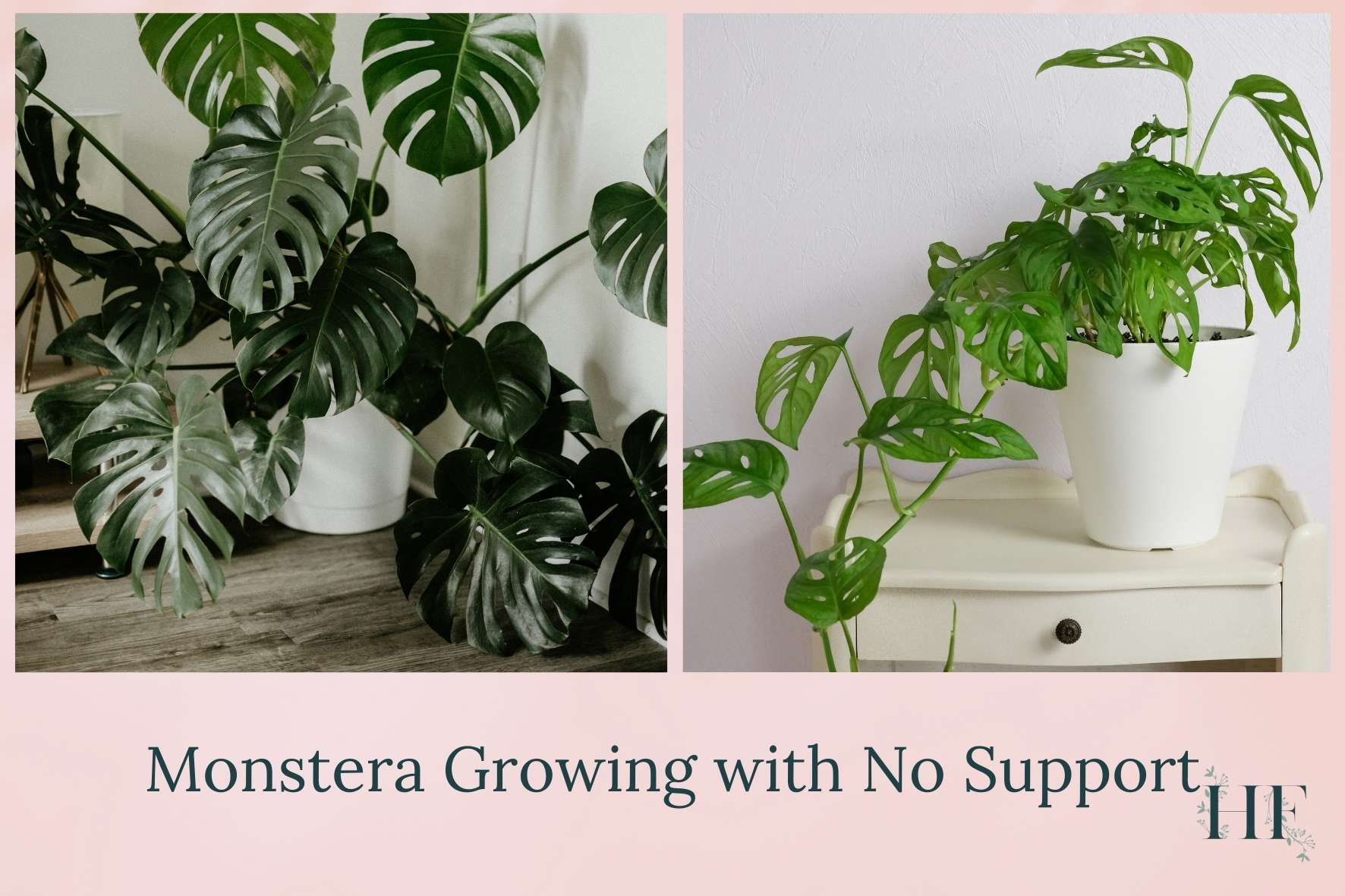
How Do You Train Monstera to Grow Straight?
Monstera Deliciosa (a.k.a. the Swiss Cheese Plant) usually grows vertically on just a few stems when it’s young, but starts to grow sideways when it gets older and heavier.
If you are looking to avoid a messy look, you are probably considering providing your Monstera with some support so it can go straight.
You can train your Monstera to grow straight and upwards by placing a strong support (like a moss pole or trellis) into the soil and letting your Monstera use this to climb.
By placing a pole or stake in the centre of the pot it will encourage your plant to go straight up from there. Whereas, if you place a trellis, for instance, at one edge, the plant will start to grow in that direction, because that is where it is finding support.
The good news is that Monsteras are vining plants, i.e., they are climbing plants. Given the right conditions and a bit of encouragement (i.e., support), you can get this plant off the floor and out of the way.
Insider Tip: Since Monsteras have a natural tendency to grow towards the light, you notice that new leaves are stretching in the direction of the light source. You can rotate your Monstera plant so that those new leaves are on the side away from the window. As the leaves reverse direction, they will grow toward the centre of the pot and help to balance it.
How Do You Train a Monstera to Climb a Wall?
Instead of using the commonly known support structures, or letting their striking foliage to trail from a pot or basket, you can let your Monstera grow against the wall.
You can train both Monstera Deliciosa and Monstera Adansonii to climb a wall by providing an appropriate support structure, in this case, a trellis or latticework (a crisscrossed framework) fixed against the wall.
Monsteras climb naturally, but it will take time for their aerial roots to attach to a support structure.
Look at this example of a Monstera Deliciosa climbing a wall and another climbing straight upwards:
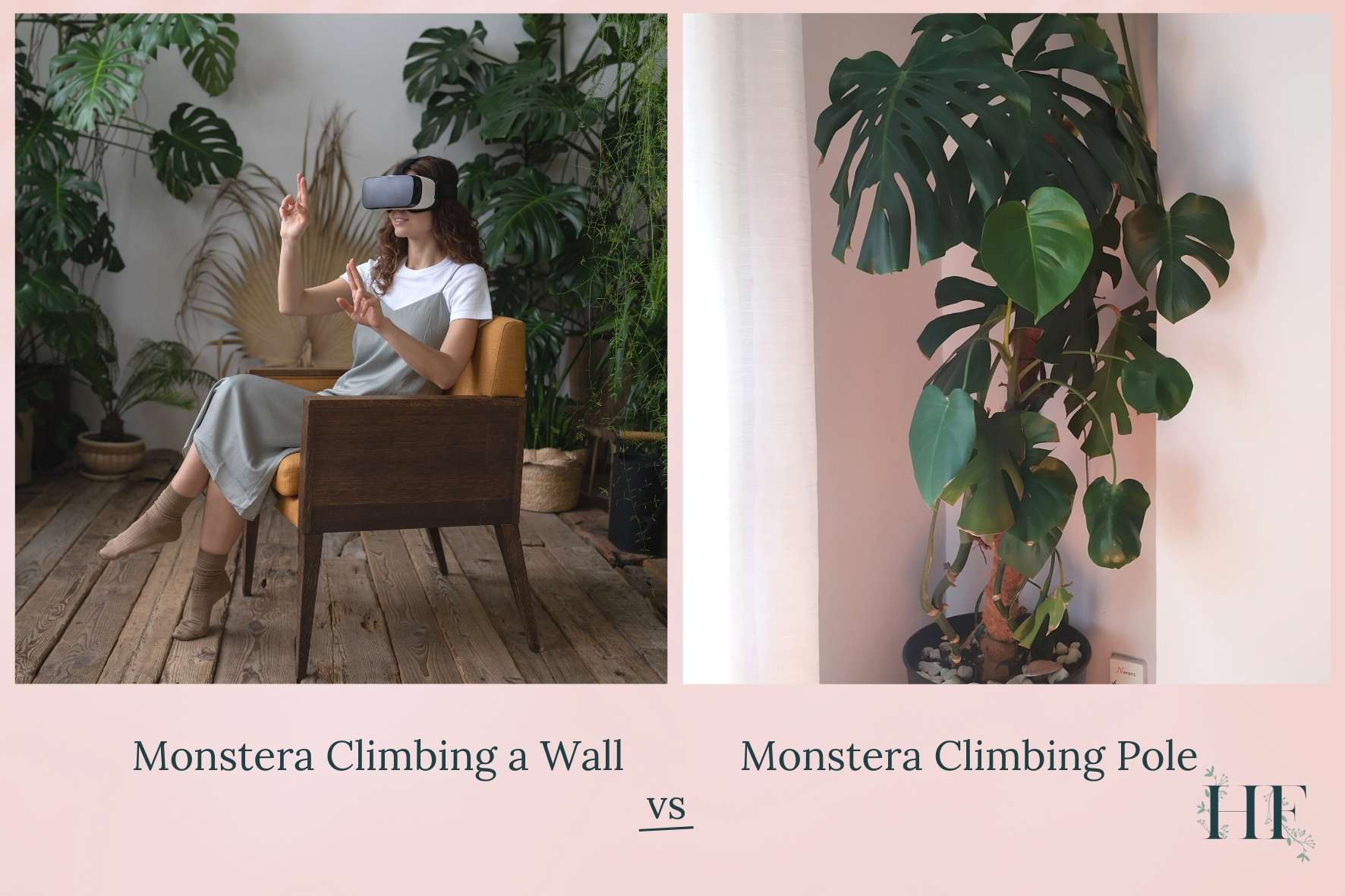
When to Put Moss Pole in Monstera
When buying a Monstera Deliciosa, if it’s a young plant, it doesn’t require any support to grow straight up. However, in the right conditions, this Monstera can grow 1 to 2 feet per year, which means that you will need to provide support sooner than you would think.
If you are purchasing a larger Monstera plant, they tend to come with a pole already included.
So, when should I support my Monstera?
Some experts recommend that the best time to add a moss pole to your Monstera’s pot is when the plant is still young. This way, it hasn’t grown a sturdy stem in a wonky direction that’s hard to bend up onto the pole.
Also, a young Monstera’s aerial roots will still be short and they can be trained directly into the pole instead of letting them grow towards the floor or a wall.
If you wait too long, it can be challenging to train a fully grown Monstera to attach to a moss pole and grow the way you want it.
On the other hand, others plant experts recommend that you should consider staking a Monstera when it starts taking up too much space or gets top-heavy.
The signs that a Monstera needs a moss pole include growth that is more horizontal than vertical, the production of aerial roots, and an unbalanced plant.
Since it’s not always clear when the right time is to add a moss pole to your Monstera, here are 4 signs that it may be time to stake your Monstera:
1) Aerial Roots Appear
When aerial roots appear, it’s a good sign that your plant is old enough and should be supported soon. They develop when the Monstera is ready to start climbing.
You will not see aerial roots in a young Monstera, but as it matures, aerial roots emerge from the stems, next to the node, and start to dangle over the sides of the pot.
One of the purposes of aerial roots is to act as an anchor for the stem to attach itself to the support system, which encourages the plant to climb.
Read also: Monstera Aerial Roots – 11 Frequent Asked Questions Answered.
2) Bent or Arching Stems
As Monstera matures, it produces larger, heavier leaves. Without support, these leaves will cause the stems to start bending under their weight.
As gravity slowly weighs the stems, they usually come to rest on the floor, or whatever surface is available.
If the leaves’ weight becomes too much, it could break the stem or cause the pot to topple over. For that reason, it is best to stake an older Monstera and give it the support it needs.
Read also: Monstera Leaves and Fenestration Stages [Split Tips Included].
3) New Growth Develops Horizontally
Monsteras can and will put out leaves from any available node along the stem, but over time you will likely start to see more growth that branches out instead of up.
There is nothing wrong with a Monstera that grows horizontally. However, people usually prefer to train their plants to grow vertically as it will take up less room and follow a tree-like growth. A horizontally growing Monstera quickly takes up more floor space!
If you start to see your plant growing outwards, it’s time to add a stake to your plant.
Additionally, pruning the new growth that occurs in unwanted areas will keep your Monstera from developing new leaves and stems in any direction but upwards.
Sometimes houseplant owners are hesitant to prune plants, but this option serves the dual purpose of training the plant to be more vertical and keeping it to a manageable size.
Read also: A Guide to Monstera Pruning (How, When and Why).
4) You Are Repotting Your Monstera
Finally, another thing to consider about the timing of installing a moss pole is if your Monstera is already in a pot or if you are repotting.
Rather than a sign from your plant, it has to do with being an ideal opportunity to support your plant!
It is better to add a moss pole at the same time that you are repotting. This way, it is less likely to disturb the roots (i.e., you can reposition the roots and avoid damaging them when placing the pole). Plus, you can get the pole deep enough to be very stable in the soil.
Also, it can be tricky to get the roots and stems to attach to a pole in an already established pot. Even if you haven’t spotted the signs mentioned above yet, this is a good time to add a support structure to your Monstera.
Insider Tip: It is better to anticipate the need to add a moss pole when you are repotting, rather than trying to add one into an established pot later.
For a step-by-step guide on repotting Monsteras, click here. Also, check my Which Type of Soil Is Best for Monstera? blog post for a Monstera repotting soil recipe.
Monstera Support Ideas
Although a Monstera pole is the most common support idea, it’s not the only option out there!
When making a choice, it’s important to consider:
- Ultimate height: The final height you would like your Monstera plant to be. Since these plants attach to the support with their aerial roots, it’s not easy to detach them again if you decide to upgrade to a taller pole later.
- Sturdiness: Make sure your trellis, moss pole, or other support is sturdy enough to hold the current and anticipated growth of your Monstera.
- Practicability: Moss poles require to be misted often, a trellis, on the other hand, needs no maintenance. Some support structures will be more viable depending on where you live and your houseplant caring routine.
- Appearance: What kind of appearance do you prefer? Even in a full and lush plant, the stakes will probably be slightly visible.
That being said… Here are the best Monstera support ideas:
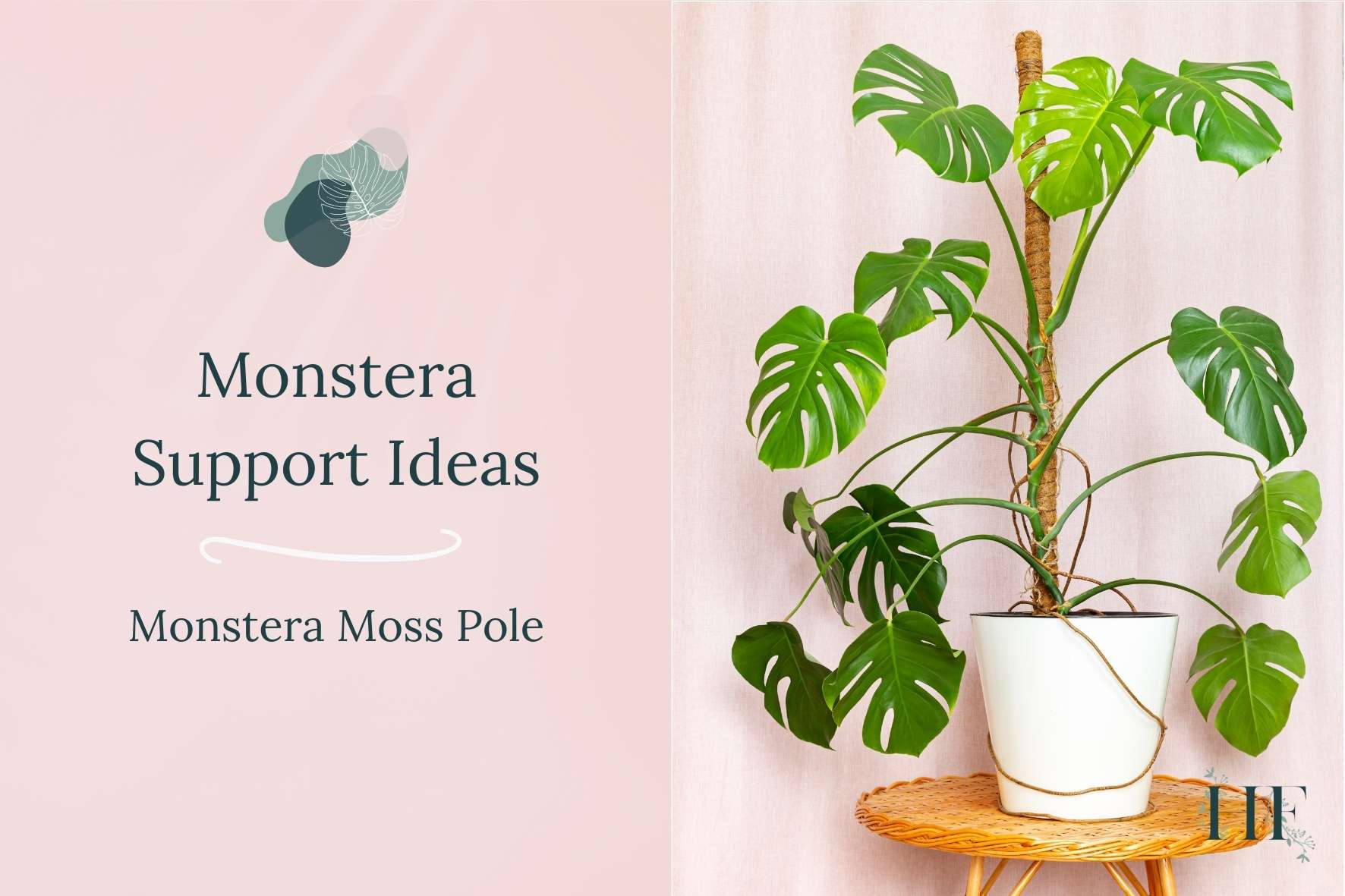
1) Monstera Moss Pole
Moss poles are perhaps the most popular and common means of supporting your Monstera.
They have a natural texture that blends in with the plant and can provide excess moisture in between waterings. This also means that you will need to keep the moss wet so the aerial roots stay attached to it. (More about how to train your Monstera around a moss pole further down).
You can either buy or make your own homemade sphagnum moss pole using a wooden stake and some sphagnum moss. Simply select a stake that is the appropriate size and height for your plant. Then, cover the wood with sphagnum moss and secure it in place by wrapping it with a fishing line or twine.
For those of you who don’t have the time for some DIY, or just don’t feel like it (no judgement here), I recommend this moss pole that comes in different sizes.
If you want your Monstera to reach your ceiling, for example, a simple moss pole is probably not going to be a long-term solution. However, continue reading to see my extendable pole suggestion.
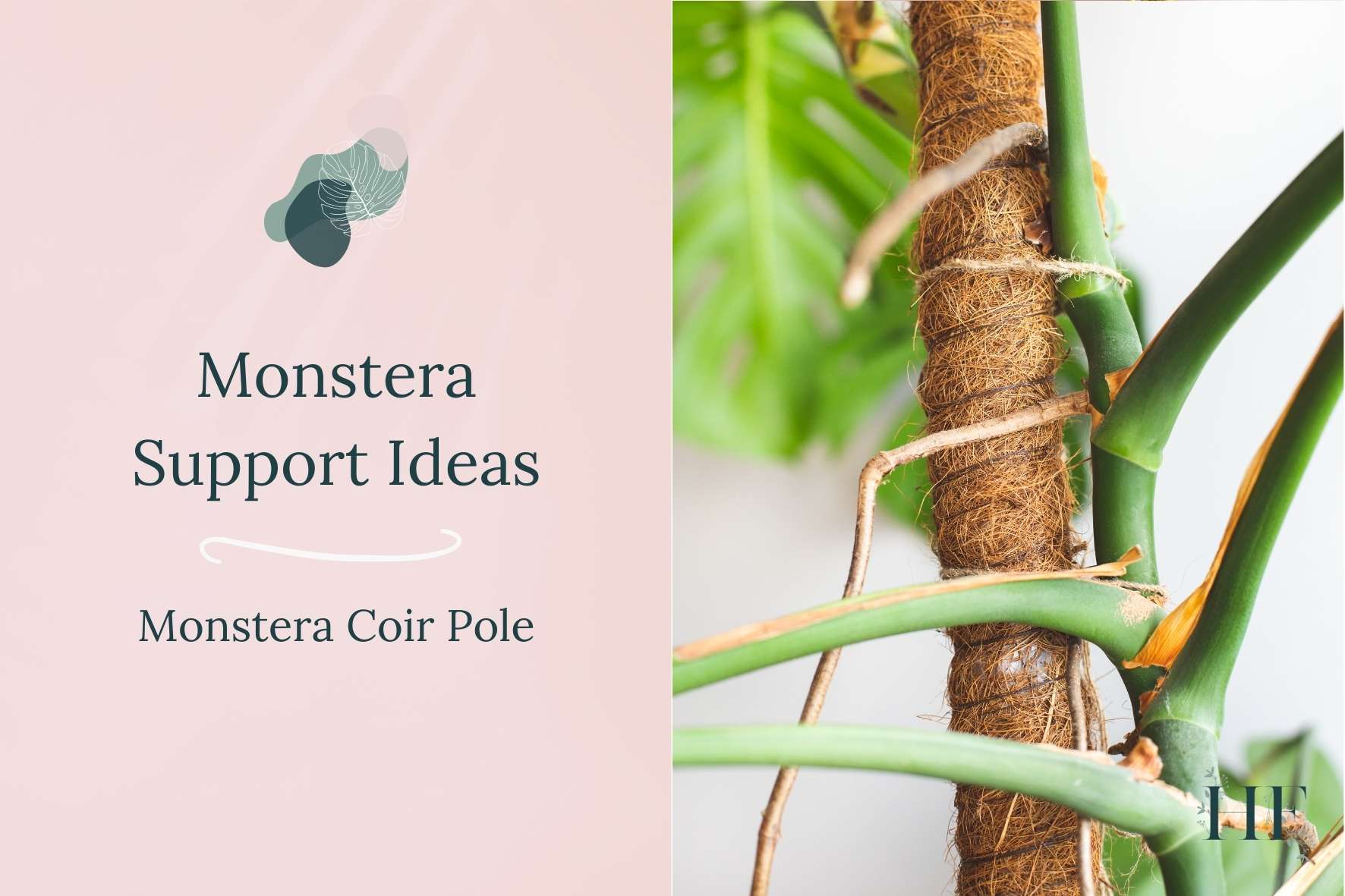
2) Monstera Coir Pole
Apart from moss, Monstera poles are also made of coco coir. They are made of the outer husk of coconuts.
These are very similar to moss poles. They also have a natural finish that can provide excess moisture, although they dry out a little faster.
The advantage of coco or moss supports is that aerial roots can latch onto this surface since it provides a stable material that’s easy for Monsteras to root into.
As an extra benefit, coco coir poles can be stacked to accommodate an increasingly growing plant. They have space in the top big enough to hold another pole’s bottom stake. All you have to do is stack it right on top!
This is ideal as you don’t need to keep changing the support. For that precise reason, I recommend this extendable coco coir pole.
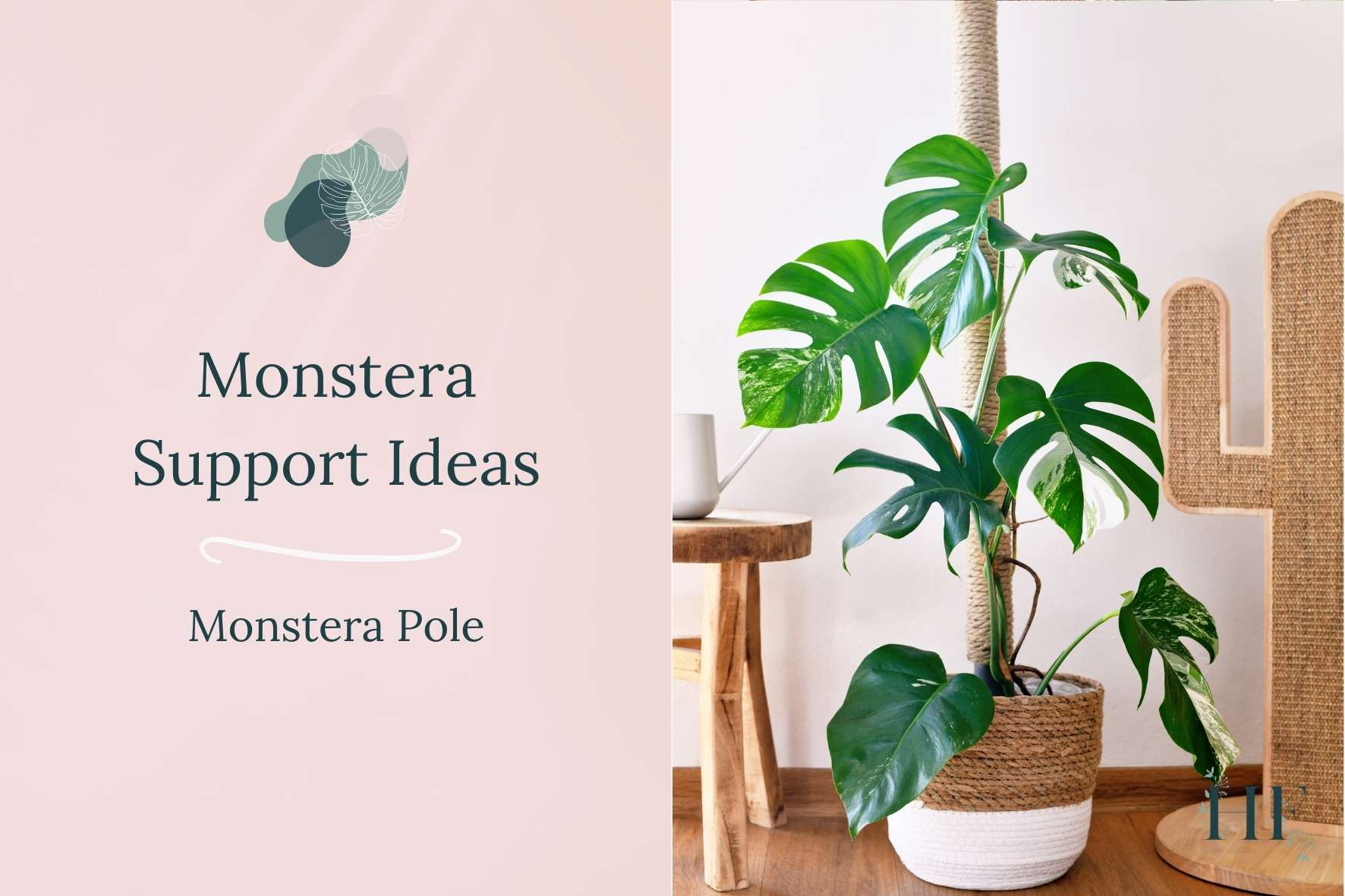
3) Jute-Covered Monstera Pole
A Monstera climbing pole can also be covered by jute. This is a rough fibre made from the stems of a plant, used for making twine and rope.
To make one of these, simply wrap the jute around a wooden stake until is fully covered. You can use dabs of hot glue to secure the jute to the wood and prevent it from unravelling.
Jute poles look great when combined with weaved baskets that are used as planters (as illustrated in the image above).
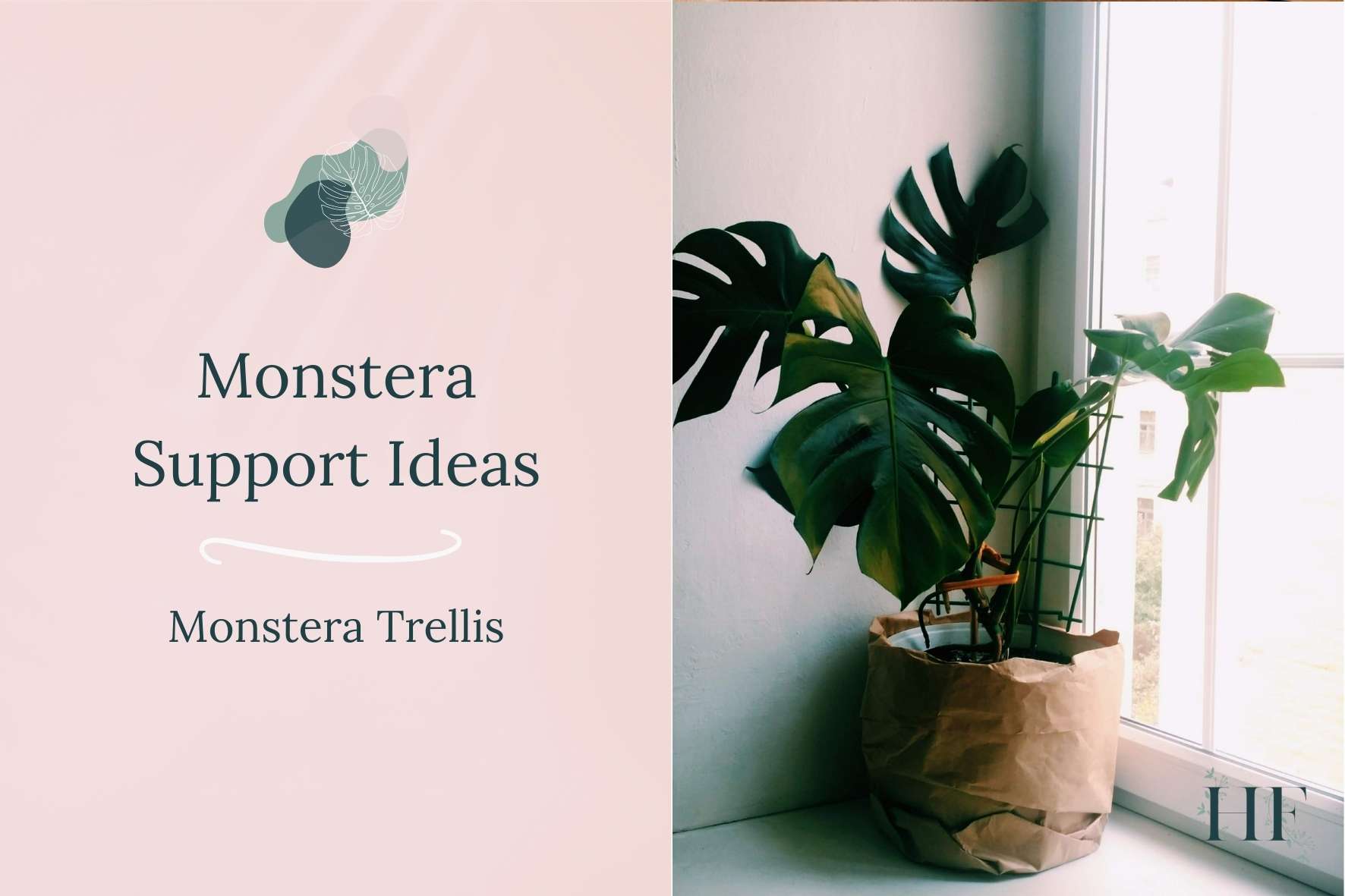
4) Monstera Trellis
Trellises can also be an effective way to support your Monstera since they are sturdy.
Most trellises are made of either wood or metal and can be found in different colours to accommodate your own preferences.
Also, you can either place the trellis inside the pot, like this trellis or you can attach it to the wall.
A downside to trellises is that the aerial roots might need some encouragement to attach to the surface. You may need to rely on twist ties in the beginning.
Trellis can also be made of plastic, like this one, which has the benefit of being extendable.
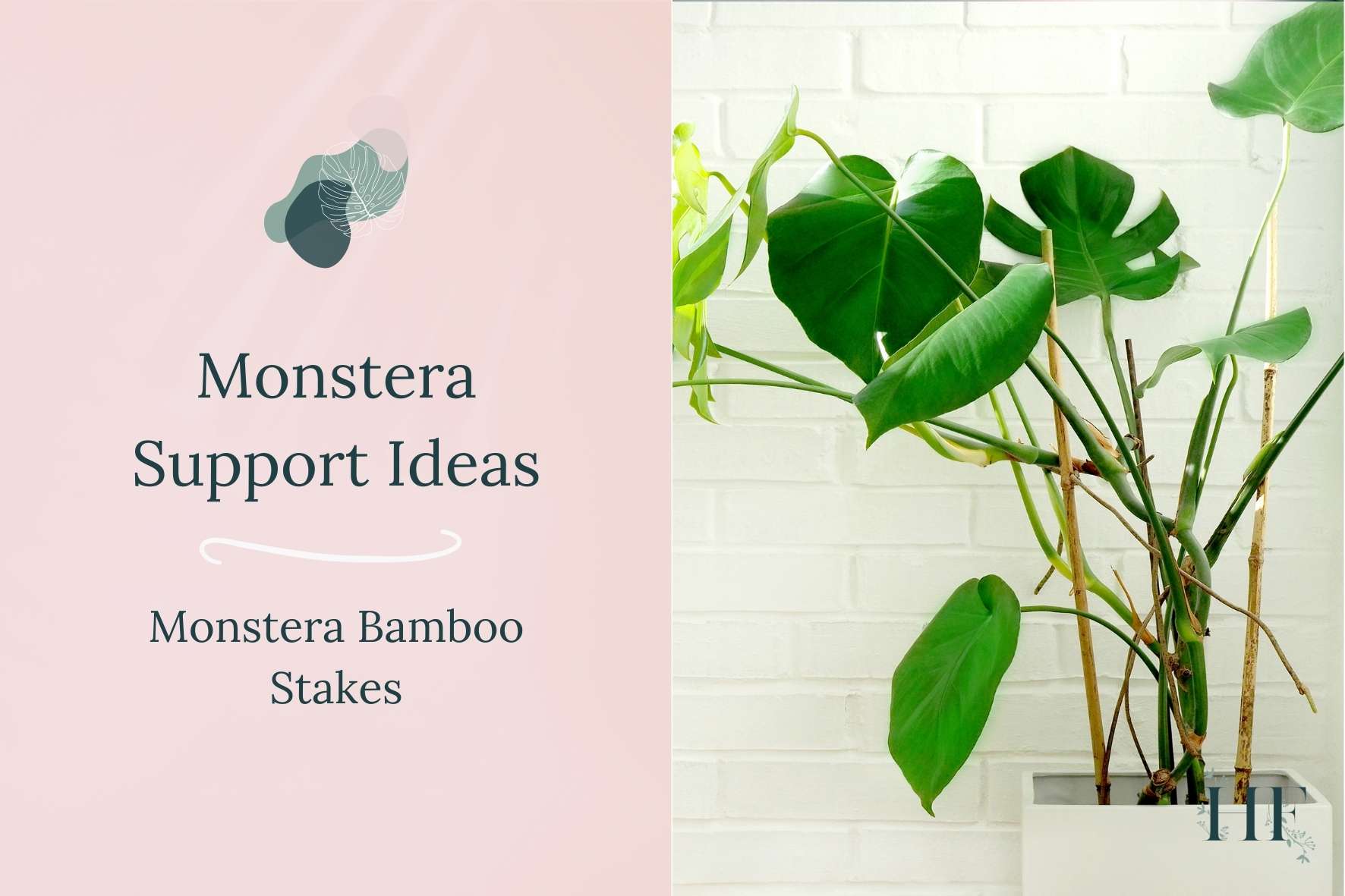
4) Monstera Stake
Bamboo stakes are another alternative to support your Monstera.
Stakes will provide vertical support but will not support aerial roots. However, you can create a bamboo trellis for extra support.
To make your own bamboo trellis (this is what I have done for now, until I repot my Monstera Deliciosa), do the following:
- Find three bamboo stakes.
- Tie the ends of the stakes together with twist ties.
- Insert the ends of the stakes in the plant pot so it makes a simple teepee.
- Train your Monstera to climb the trellis. You may need to tie the stem to the bamboo stake too.
Alternatively, you can get an already made bamboo trellis.
The downside of bamboo stakes is that the slimmer ones are not sturdy enough to support a mature Monstera. Also, the aerial roots are less likely to twine themselves around these.
5) Hanging Rope
Some people will also use a rope to suspend Monstera stems from above, which is great for vertical growth if you don’t mind its look.
This is an example of how you can support a Monstera by using a rope to suspend Monstera stems from above.
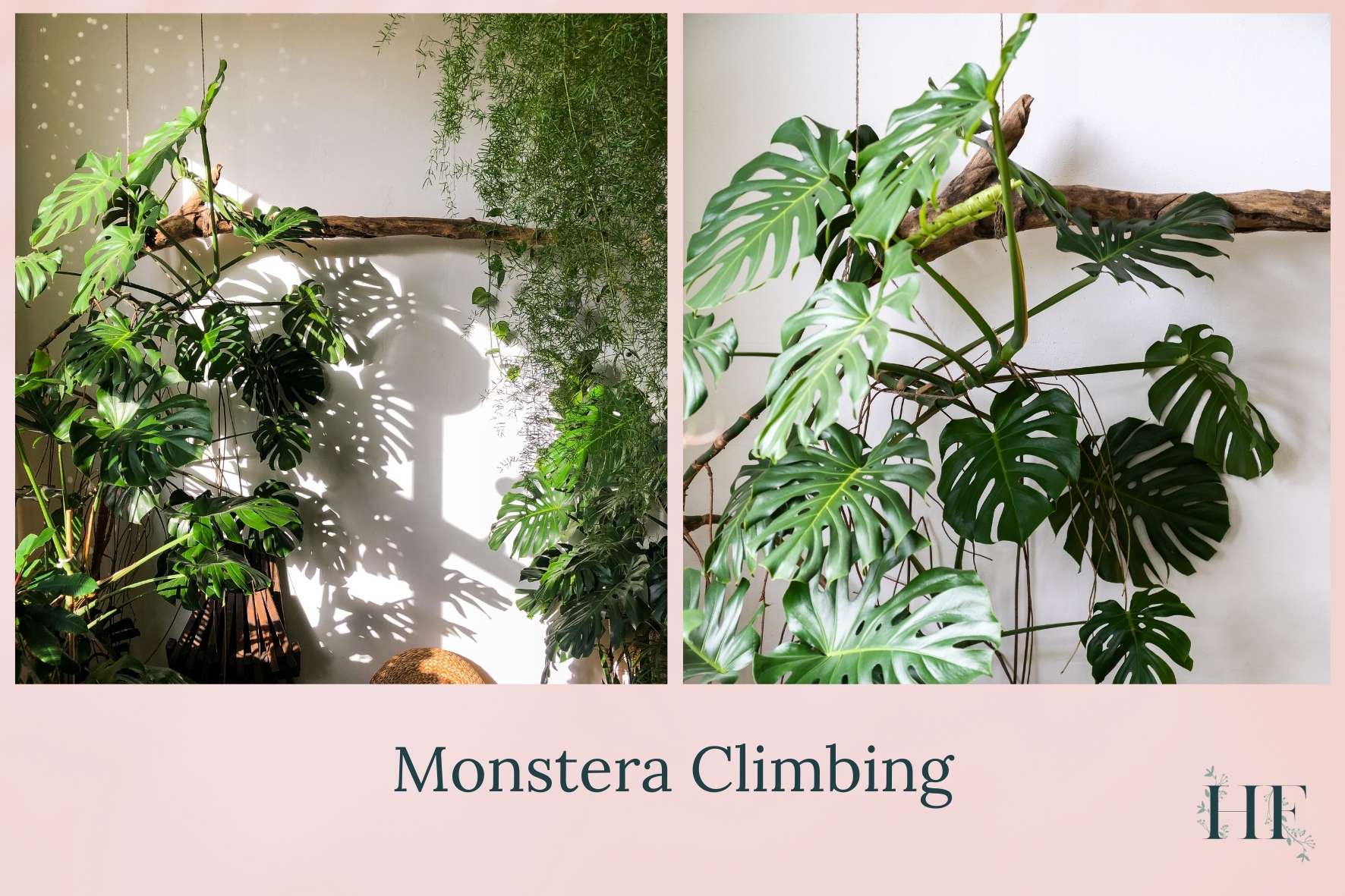
How to Train Your Monstera to Climb
Once you decide that it’s time to stake your Monstera, let’s go through how to secure your Monstera to a moss or coir pole.
1) Considerations Before Staking Your Monstera
Here are a few things to keep in mind when installing a moss pole for your Monstera:
1.1) Avoid Disturbing the Roots
It is best to add a new pole when you are in the process of repotting your Monstera to avoid damaging the roots when inserting the stake into the soil.
However, if your Monstera is happy in its pot, just be careful when inserting the pole. Gently dig out a space close to the centre of the pot (this way you can see the roots and will avoid smashing them) and then stick the pole as far down as you can.
1.2) Maximize Pole Stability
To make sure that the pole is stable in the pot…
First, place the pole in the centre of the pot to keep the weight of the pole and the plant balanced. If it is too far to one side of the pot, it’s more likely for your Monstera to topple over.
Afterwards, make sure the soil is not loose around the pole. Pack the soil in after placing the pole and again after watering.
1.3) Choose an Appropriate Pole Size
The pole should be at least a couple of feet taller than your Monstera. This way, it has some room to grow and climb. Also, consider getting a stackable pole.
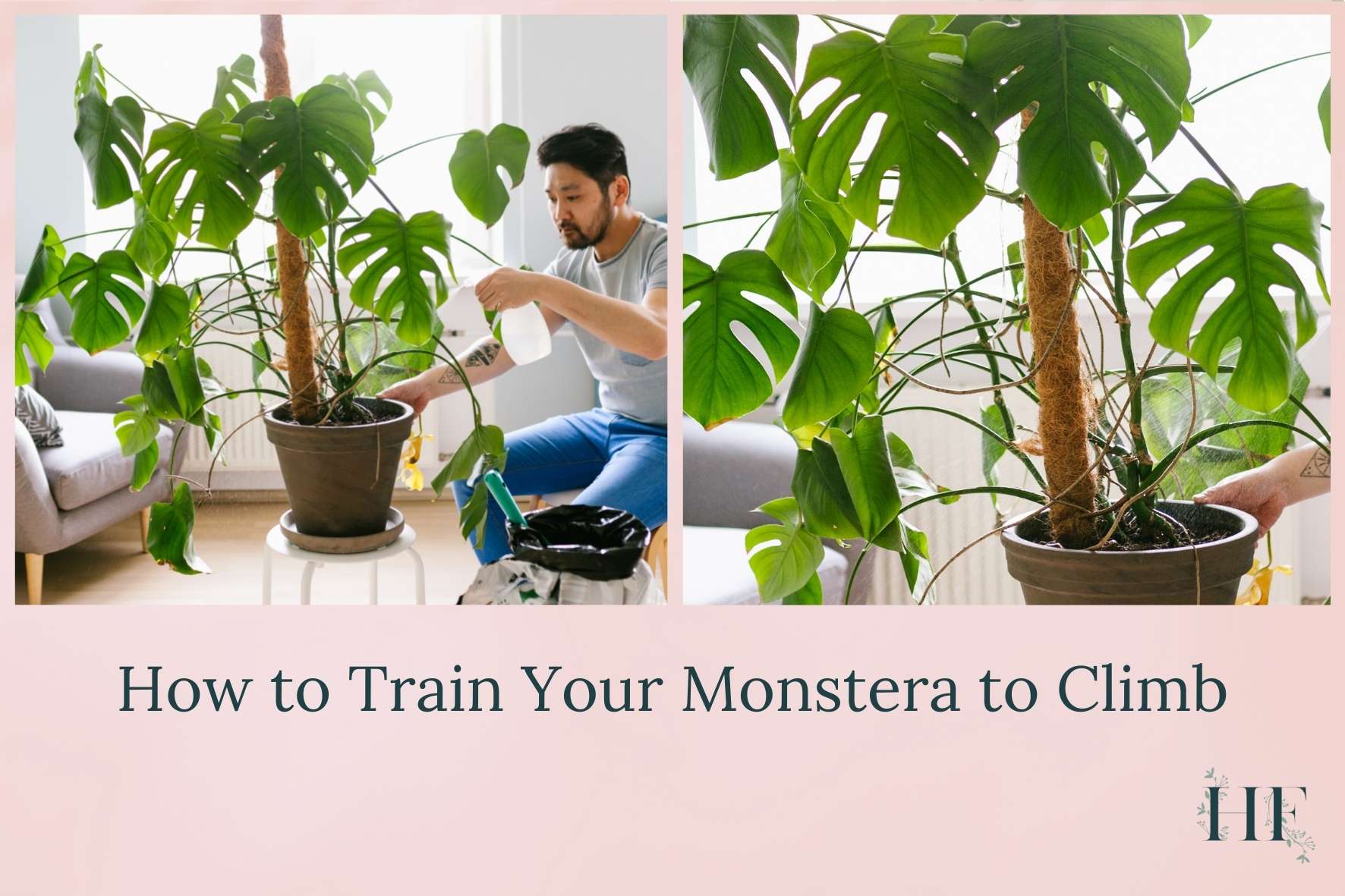
Now, here’s how to train your Monstera around a moss pole:
2) Pick a Pole and Stake It
After going through the Monstera Support Ideas section, you probably have an idea of what type of support you prefer.
When it comes to staking, you want to keep the support and pot stable. To do so, insert the pole in the centre of the pot, that way the weight will be balanced. If the pole or trellis is too far to one side of the pot, it’s more likely for your Monstera to topple over.
If you are staking your Monstera whilst repotting, you will be able to place the stake first on the pot and then arrange the Monstera roots around it.
However, if you are adding a stake to an already established potted Monstera, dig a hole in the middle and try to keep the roots out of the way. Afterwards, make sure the soil is not loose around the pole. You can add more soil after placing the pole and again after watering.
3) Secure Your Monstera to the Pole or Trellis
There are two points that you want to use to anchor your Monstera in place, to make sure it attaches and climbs the support structure: the main stem and the aerial roots.
First, you want to anchor the largest, heaviest stems, and secondly, you want to encourage the aerial roots to attach (refer to step 4).
If your Monstera is still young, without tugging or bending too hard, tie the Monstera’s stem to the pole, so the nodes are touching the damp moss or coir. This will encourage the aerial roots to grow into and around the moss pole.
If your Monstera is already fairly mature, it may not want to bend so much to attach to the pole since they are not as flexible as thinner stems. Then, you will have to do this step slowly, in stages. Use ties to start pulling the stem toward the pole, and tighten them every week until the stem is against the pole.
When necessary, cut back some of the Monstera’s aerial roots if they are very long. The longer they are, the harder it will be to train them on to your chosen support.
If you cut the aerial roots close to the node, it will encourage more aerial root growth, which will now grow onto the moss pole!
Note that you may need to repeat this process with any new growth. Once the Monstera’s aerial roots are firmly attached to the moss pole, you can remove or loosen the ties.
You can attach the stems of a Monstera to a pole or trellis using twist ties (this is what I use), which is a rubberised garden wire that doesn’t damage the plant.
Avoid using string or twine since it can cut into the plant’s stem.
4) Train Your Monstera So It Attaches to the Pole
When using a moss or coir pole, here’s how to train your Monstera aerial roots:
It may take a while, but as long as you keep the moss or coir pole damp, the aerial roots should eventually attach to it.
High humidity is the key to success here. If you have low humidity, you may struggle to get the roots to attach. For increasing your Monstera’s humidity levels, check here.
Since aerial roots are the ultimate anchors, you can guide them by wrapping or draping the aerial roots around the support structure.
Alternatively, you can use twist ties again to bind the aerial roots to the support. The points where the aerial roots are touching will eventually grab on to the support.
If your Monstera does not yet have aerial roots, just skip that step for now. Once you see them emerging, you can direct them toward the moss pole as soon as they are long enough.
Here are some examples of how to train your Monstera Adansonii to climb:
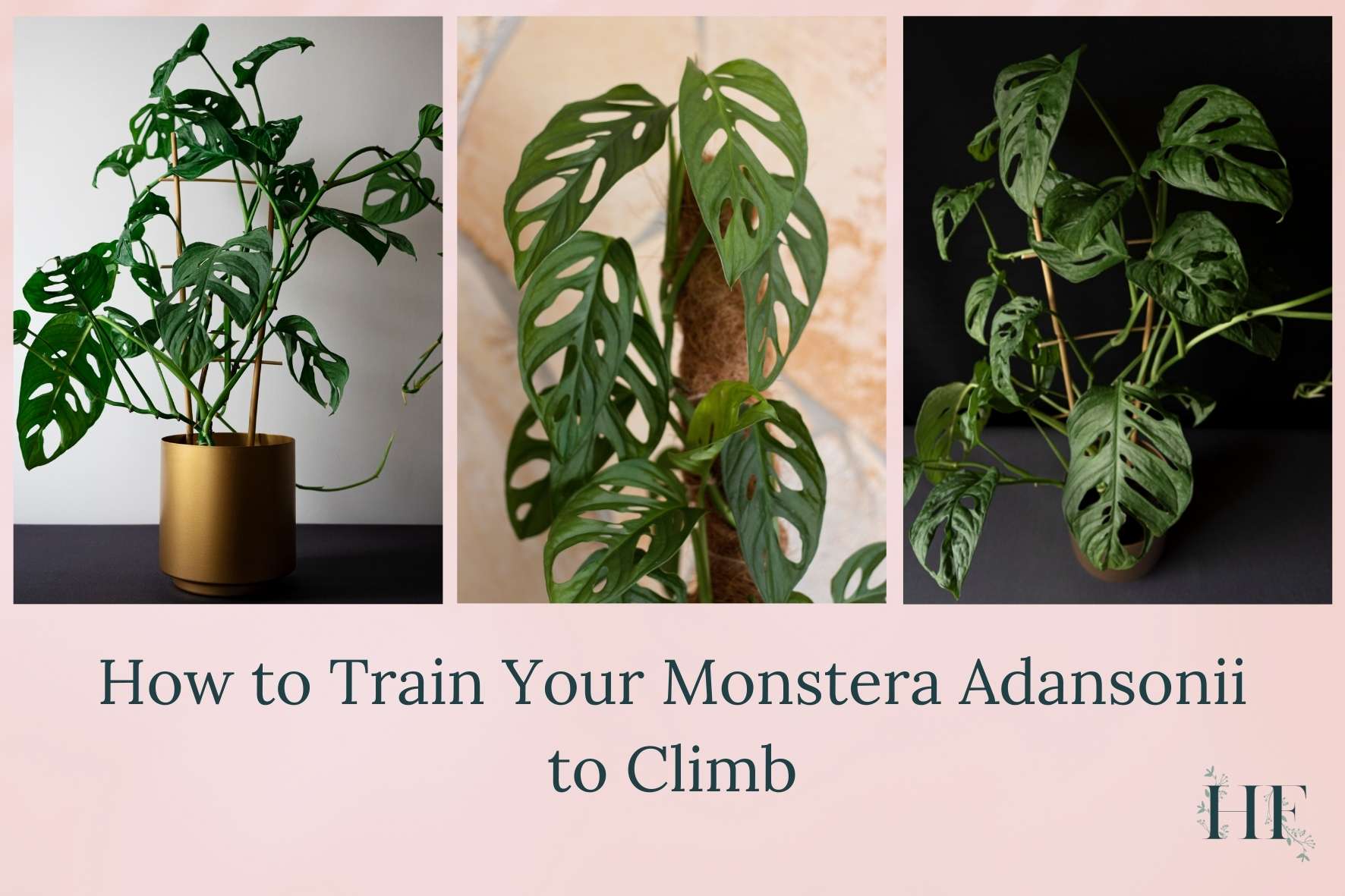
5) Mist the Moss or Coir Pole Regularly
Monstera’s aerial roots will be naturally attracted to the moss or coir pole, but only if it is damp. That’s why it is key to mist the pole regularly.
Finally, extend the pole when necessary.

